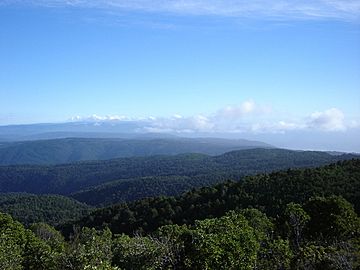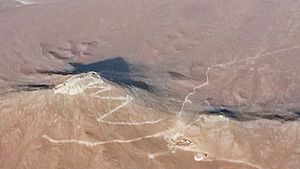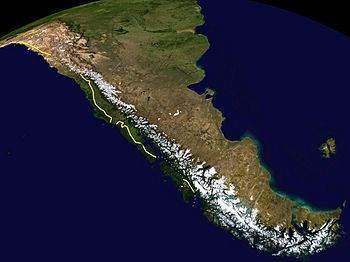Chilean Coast Range facts for kids
Quick facts for kids Chilean Coastal Range |
|
|---|---|

View from Cerro Oncol
|
|
| Highest point | |
| Peak | Cerro Vicuña Mackenna |
| Elevation | 3,114 m (10,217 ft) |
| Dimensions | |
| Length | 3,100 km (1,900 mi) North-South |
| Geography | |
| Country | Chile |
| Range coordinates | 32°58′32″S 71°00′49″W / 32.9756°S 71.0135°W |
| Parent range | Andes |
The Chilean Coastal Range (in Spanish: Cordillera de la Costa) is a long chain of mountains. It stretches from north to south along the Pacific Ocean coast of South America. These mountains run right next to the huge Andes mountains.
The range starts in the north at Morro de Arica and goes all the way south to the Taitao Peninsula. It greatly affects the climate of Chile. It creates a "rain shadow" effect to its east. This means the side facing the ocean gets a lot more rain. So, plants grow much better on the western slopes. The areas within the range are not very crowded. People use the land for things like nature reserves, grazing animals, and growing trees for wood. You can find this mountain range in almost all parts of Chile.
Contents
Where is the Chilean Coastal Range?
Just like the Andes, the Chilean Coastal Range gets lower as you go further south. It begins in the north at Morro de Arica. The highest point is Sierra Vicuña Mackenna, which is 3,114 meters tall. This peak is in the Antofagasta Region.
Northern and Central Sections
Between the Copiapó and Aconcagua rivers, the coastal range actually joins with the Andes. This area is called Norte Chico. North of Santiago, the range separates from the Andes. But it gets close again near Paine and San Fernando.
South of Santiago, the mountains become lower. They continue until the Bío Bío River. After this river, a new part of the range appears. This is the Cordillera de Nahuelbuta, which reaches about 1,500 meters high.
Southern Sections
South of the Nahuelbuta Range, in the Araucanía Region, the coastal range turns into a flat area. But south of the Toltén River, the mountains rise again. This part is called the Cordillera de Mahuidanchi.
Further south, near Corral, this range changes into the Cordillera Pelada. From the Chacao Channel southward, the sea cuts into the range. This creates many islands and peninsulas. Chiloé Island is the biggest of these islands. It has two mountain parts: the Cordillera del Piuchén and the Pirulil Range.
Even further south of Chiloé, parts of the range that are above sea level form island groups. These include the Guaitecas Archipelago and the Chonos Archipelago. The very end of the range forms the Taitao Peninsula.
Smaller Mountain Groups
The Chilean Coastal Range is made up of several smaller mountain groups. Some of these include:
- Sierra Vicuña Mackenna (around 24–25° S latitude)
- Vizcachas Mountains (around 33° S latitude)
- Cordillera de Nahuelbuta (around 37–38° S latitude)
- Cordillera de Oncol (around 39° S latitude)
- Cordillera Pelada (around 40° S latitude)
- Cordillera del Piuchén (around 42° S latitude)
- Pirulil Range (around 42–43° S latitude)

How the Mountains Formed
The Chilean Coastal Range did not form in just one way. It is a mix of different landforms that lined up along Chile's coast. These include uplifted blocks of land and high areas that formed in front of ancient volcanoes.
The range became separate from the Andes mountains a very long time ago. This happened when the land in between them, called the Intermediate Depression, sank down. This sinking occurred as the Andes mountains were rising.
What the Mountains are Made Of
The rocks that make up the range are different in various places. From the Valparaíso Region to the Lanalhue Fault, the main rock is from the Coastal Batholith of central Chile. These are igneous rocks, which formed from cooled magma deep underground. They were once part of an older chain of volcanoes.
South of the Lanalhue Fault, much of the range is made of Bahía Mansa Metamorphic Complex. These are metamorphic rocks, like schist, which have changed due to heat and pressure.
Millions of years ago, during the Miocene epoch, some parts of the Chilean Coastal Range had volcanoes. Today, there are no active volcanoes in this range.
The northern part of the range has many iron ore deposits. These are valuable minerals found along a large crack in the Earth's crust called the Atacama Fault.
See also
 In Spanish: Cordillera de la Costa (Chile) para niños
In Spanish: Cordillera de la Costa (Chile) para niños
- Climate of Chile
- Geology of Chile
- Chilean Central Valley
- Atacama Desert


